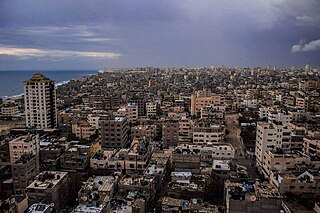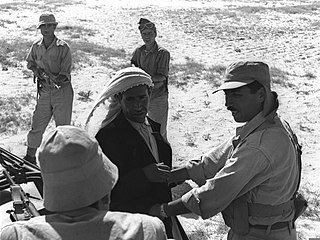Related Research Articles
This timeline of the Israeli–Palestinian conflict lists events from 1948 to the present. The Israeli–Palestinian conflict emerged from intercommunal conflict in Mandatory Palestine between Palestinian Jews and Arabs, often described as the background to the Israeli–Palestinian conflict. The conflict in its modern phase evolved since the declaration of the State of Israel on May 14, 1948 and consequent intervention of Arab armies on behalf of the Palestinian Arabs.

Khan Yunis, also spelled Khan Younis or Khan Yunus, is a Palestinian city serving as the capital of the Khan Yunis Governorate in the southern Gaza Strip. It has been largely destroyed on account of the ongoing Israel–Hamas war.

The Popular Resistance Committees is a coalition of a number of armed Palestinian groups opposed to what they regard as the conciliatory approach of the Palestinian Authority and Fatah towards Israel.

Khalil Ibrahim al-Wazir was a Palestinian leader and co-founder of the nationalist party Fatah. As a top aide of Palestine Liberation Organization (PLO) Chairman Yasser Arafat, al-Wazir had considerable influence in Fatah's military activities, eventually becoming the commander of Fatah's armed wing al-Assifa.

Nonie Darwish is an Egyptian-American writer, founder of Arabs for Israel movement, and is Director of Former Muslims United. Darwish is an outspoken critic of Islam. The Southern Poverty Law Center has described her as an anti-Arab and anti-Muslim activist.

Salah Mustafa Muhammad Shehade was a member of the Palestinian Islamist movement Hamas. He led the Izz ad-Din al-Qassam Brigades military wing of Hamas, until his assassination by Israel.

Palestinian political violence refers to actions carried out by Palestinians with the intent to achieve political objectives that can involve the use of force, some of which are considered acts of terrorism, and often carried out in the context of the Israeli–Palestinian conflict. Common objectives of political violence by Palestinian groups include self-determination in and sovereignty over all of Palestine, or the recognition of a Palestinian state inside the 1967 borders. This includes the objective of ending the Israeli occupation. More limited goals include the release of Palestinian prisoners held by Israel and recognition of the Palestinian right of return.

Palestinian return to Israel refers to the movement of Palestinians back into the territory of present Israel.
Ahmed al-Jabari, also known as Abu Mohammad, was a senior leader and second-in-command of the military wing of Hamas, the Izz ad-Din al-Qassam Brigades. He was widely credited as the leading figure in the Hamas takeover of the Gaza Strip, and commanded the 2006 Hamas cross-border raid which resulted in the capture of Israeli soldier Gilad Shalit. Under his command, along with chief logistics officer Mahmoud al-Mabhouh, Hamas developed its own military weapons capability significantly by acquiring longer-range guided missiles and rockets.

Palestinian fedayeen are militants or guerrillas of a nationalist orientation from among the Palestinian people. Most Palestinians consider the fedayeen to be freedom fighters, while most Israelis consider them to be terrorists.

Shayetet 13 is a unit of the Israeli Navy and one of the primary reconnaissance units of the Israel Defense Forces. Shayetet 13 specializes in sea-to-land incursions, counter-terrorism, sabotage, maritime intelligence gathering, maritime hostage rescue, and boarding. The unit is trained for sea, air and land actions. The unit has taken part in almost all of Israel's major wars, as well as other actions.

Reprisal operations were raids carried out by the Israel Defense Forces in the 1950s and 1960s in response to frequent fedayeen attacks during which armed Arab militants infiltrated Israel from Syria, Egypt, and Jordan to carry out attacks on Israeli civilians and soldiers. Most of the reprisal operations followed raids that resulted in Israeli fatalities. The goal of these operations – from the perspective of Israeli officials – was to create deterrence and prevent future attacks. Two other factors behind the raids were restoring public morale and training newly formed army units. A number of these operations involved attacking villages and Palestinian civilians in the West Bank, including the 1953 Qibya massacre.
Events in the year 1956 in Israel.

Operation Black Arrow was an Israeli military operation carried out in Gaza on 28 February 1955. The operation targeted the Egyptian Army. Thirty-eight Egyptian soldiers were killed during the operation as were eight Israelis.

The Khan Yunis massacre took place on 3 November 1956, perpetrated by the Israel Defense Forces (IDF) in the Palestinian town of Khan Yunis and the nearby refugee camp of the same name in the Gaza Strip during the Suez Crisis.

The Palestinian Fedayeen insurgency was an armed cross-border conflict, which peaked between 1949 and 1956, involving Israel and Palestinian militants, mainly based in the Gaza Strip, under the nominal control of the All-Palestine Protectorate – a Palestinian client-state of Egypt declared in October 1948, which became the focal point of the Palestinian fedayeen activity. The conflict was parallel to the Palestinian infiltration phenomenon. Hundreds were killed in the course of the conflict, which declined after the 1956 Suez War.
Mass civilian casualties of Israeli bombing, shelling and rocket attacks on the Gaza Strip have occurred in the Israeli–Palestinian conflict, in which Israeli bombing attacks on the Gaza Strip cause numerous civilian fatalities. The reason for such operations is purportedly to carry out targeted assassinations of militants from Hamas, Islamic Jihad and other groups seen to be a threat to Israel, whose Shin Bet data banks monitor thousands of Palestinians for targeting. Israel regards such cases as either unfortunate errors, the consequence of civilians being allegedly used to shield militants, or as acceptable collateral damage.
References
- 1 2 Saab, Sheren Falah (2024-04-11). "Egyptian Activist Nonie Darwish: I Asked in Class, 'Why Do We Hate Jews So Much?'". Haaretz . Retrieved 19 September 2024.
- ↑ Filiu, Jean-Pierre (Spring 2012). "The Origins of Hamas: Militant Legacy or Israeli Tool?". Journal of Palestine Studies. 41 (3): 54–70. Retrieved 19 September 2024.
- ↑ Melman, Yossi (2004-03-24). "Targeted Killings - a Retro Fashion Very Much in Vogue". Haaretz . Retrieved 19 September 2024.
- ↑ Schiff, Ze'ev (2024). A History of the Israeli Army: 1874 to the Present. Simon and Schuster.